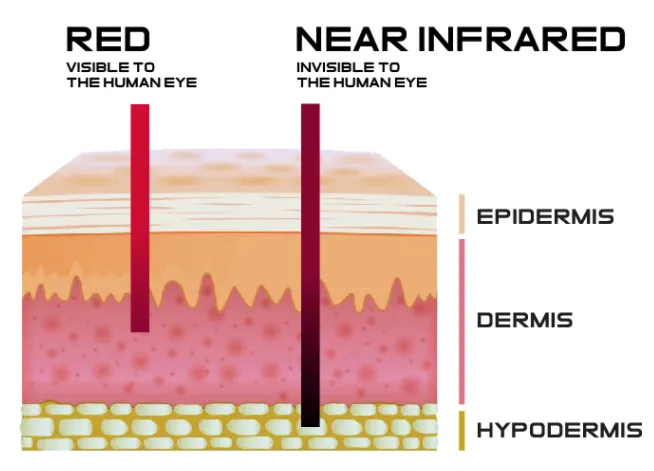
In recent years, LED light therapy has shifted from the professional clinic to the comfort of people’s homes. Once seen only in dermatology offices, these devices are now widely available in consumer-friendly forms: masks, handheld tools, and even portable panels. They promise improvements in acne, fine lines, skin tone, and overall radiance. Yet with so many options on the market, the question remains:how do you choose the right LED light therapy device for your skin type?
This guide breaks down the science behind LED light therapy, explains the differences between wavelengths, and provides practical advice tailored to specific skin concerns.
LED (light-emitting diode) therapy works by delivering specific wavelengths of light energy into the skin. Unlike UV rays, which can damage the skin, LED light is non-invasive and safe when used properly. Each wavelength penetrates the skin at a different depth and triggers various biological processes:
Red light (around 630–660 nm):Stimulates collagen production, improves circulation, and helps reduce fine lines and wrinkles.
Blue light (around 405–420 nm):Targets acne-causing bacteria, reduces breakouts, and calms inflammation.
Near-infrared light (around 800–900 nm):Penetrates deeper layers to support healing, reduce inflammation, and improve skin elasticity.
Yellow or amber light (around 580–600 nm):Brightens skin, reduces redness, and soothes sensitive areas.
Because each skin type responds differently, the correct choice depends on your personal concerns and overall skin health.
Before choosing a device, take time to identify your skin type. Dermatologists often use theFitzpatrick scale, which classifies skin based on how it reacts to sun exposure, but in daily practice, it’s often easier to consider whether your skin is:
Oily and acne-prone
Dry or sensitive
Combination (oily in some areas, dry in others)
Normal (well-balanced, minimal concerns)
Mature or aging
Each category may benefit from different wavelengths and device designs.
For individuals struggling with frequent breakouts,blue light therapyis often the most effective. Blue light works by destroyingCutibacterium acnes, the bacteria that cause inflammation and pimples. Some devices combine blue and red light—this pairing not only reduces bacteria but also helps calm redness and repair the skin barrier.
What to look for:
Devices with strong blue light coverage.
Combination devices offering blue + red light.
Adjustable treatment intensity to avoid irritation.
If your skin becomes easily irritated, you’ll want a gentler option.Red and amber lightare beneficial because they encourage collagen production and circulation without aggravating sensitivity. Yellow/amber light in particular can reduce redness and support recovery after flare-ups.
What to look for:
Masks or panels with low-heat emission.
Adjustable timers to avoid overexposure.
Gentle wavelengths (amber, red).
For those with both oily patches and dry zones, a versatile device is ideal. Amulti-wavelength maskthat offers both blue and red light allows you to target blemishes while still addressing overall tone and texture.
What to look for:
Devices with multiple wavelength options.
Flexibility to switch modes depending on flare-ups.
Even light distribution across the whole face.
Even if you have minimal concerns, LED therapy can be used preventively.Red and near-infrared lightcan maintain firmness and slow the natural aging process. Occasional blue light sessions can also help keep skin balanced.
What to look for:
Comfortable, easy-to-use devices.
Maintenance-focused light modes (red, infrared).
With age, collagen production declines, leading to wrinkles, sagging, and uneven tone.Red and near-infrared lightare the gold standards here. These wavelengths reach the deeper dermis to stimulate fibroblasts (collagen-producing cells) and improve elasticity.
What to look for:
Devices with strong red and infrared output.
Consistent energy delivery (not just cosmetic “glow”).
Mask or panel formats for full-face coverage.
LED devices come in several forms, and the right choice depends on lifestyle, budget, and convenience.
LED Masks:Offer full-face treatment and often include multiple wavelength options. Best for people seeking anti-aging and overall complexion benefits.
Handheld Devices:Compact and affordable, but require more effort to cover the whole face. Suitable for targeting small areas like acne spots or wrinkles.
LED Panels:Provide strong light output and can treat larger areas of the face or body. Commonly used in professional or dedicated home skincare routines.
When evaluating design, also pay attention to comfort features such as strap adjustments, weight, and eye protection.
Since LED light therapy involves direct exposure to light energy, safety is critical. Always choose devices with clear certification marks such asFDA clearance (for U.S. buyers)orCE marking (for European buyers). These indicate that the device has undergone testing for safety and effectiveness.
Additional tips:
Avoid unbranded or extremely cheap devices with no clinical backing.
Ensure the device includes protective measures (auto shut-off, safety goggles if needed).
Read customer reviews focusing on both results and comfort.
While LED therapy is effective, it’s not a miracle overnight treatment. Most studies suggest that visible improvements appear after4–8 weeks of consistent use, depending on skin type and concerns. A few points to remember:
Daily or every-other-day sessions of 10–20 minutes are common.
Improvements in acne may appear faster than anti-aging results.
Maintenance sessions are required to preserve results.
Think of LED light therapy as a long-term investment in skin health rather than a quick fix.
Even the best device works best when paired with good skincare habits. Consider these tips:
Cleanse before treatment:Makeup or dirt can block light penetration.
Moisturize afterward:Light therapy can increase skin activity, so hydration is essential.
Use sunscreen daily:While LED light is safe, protecting your skin from UV remains critical.
Avoid conflicting products:Harsh exfoliants or strong retinoids may make the skin more sensitive during therapy.
Choosing the right LED light therapy device is not just about picking the most expensive or popular option—it’s about aligning the technology with your unique skin type.
Acne-prone? Look for blue light or a combination of blue and red.
Sensitive? Opt for gentle amber or red light with lower intensity.
Mature skin? Prioritize red and near-infrared wavelengths for collagen support.
Combination or normal skin? A versatile, multi-wavelength mask may be the best investment.
Above all, prioritize safety certifications, realistic expectations, and consistency. With thoughtful selection, LED light therapy can become a safe, effective, and empowering addition to your skincare journey.